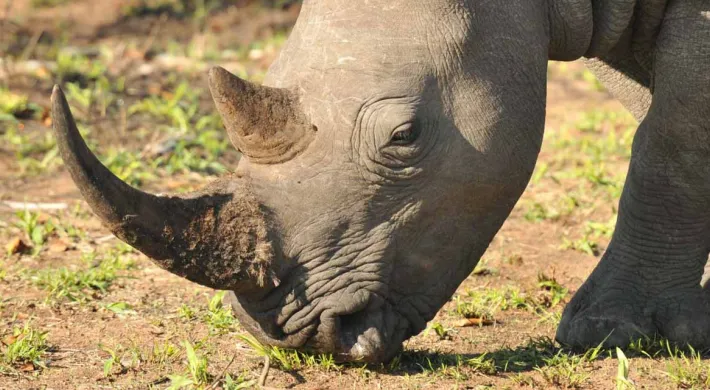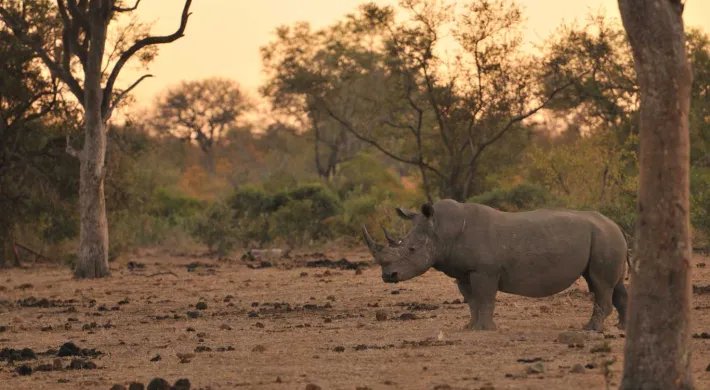North Carolina Zoo Mourns Loss of Natalie, Rhino with ‘Big Personality’
Additional images available here, photo credit North Carolina Zoo
Asheboro, N.C. Jan. 17, 2023 -The North Carolina Zoo sadly announces the death of Natalie, a southern white rhinoceros who was euthanized on Jan. 10 after a period of declining health.
Zookeepers said Natalie, 30, had a personality that matched her big 4,000+ pound size. Southern white rhinos are the second-largest land mammal after elephants.
The veterinarian and animal care teams had been treating Natalie for chronic kidney failure, anemia, and multisystemic disease for the past several months. “Unfortunately, her health was in a steep decline despite treatment efforts, which led to a decrease in quality of life,” said Associate Veterinarian for the North Carolina Zoo, Dr. Tim Georoff. “This week, the animal care and vet teams made the difficult decision to euthanize Natalie when treatment efforts were no longer effective."
Georoff said the full pathology report will provide more information about Natalie’s condition in the coming weeks.
Natalie arrived at the North Carolina Zoo with her son Lyonnel in 2007. She had previously lived most of her life at White Oak Conservation Center in Florida, where she gave birth to two males named Tony and Dominique. All three of her offspring are still living at other accredited zoos in North America.
Southern white rhinos are the most social of the rhino species and live together in groupings called "crashes." Rhinos in the wild live into their early 30s and can live into their early 40s under human care.
The North Carolina Zoo now has a rhino crash of seven females—Linda, Kit, Abby, Nandi, Bonnie, Jojo and Mguu.
Natalie was a tough, independent female when she arrived at the Zoo who gradually softened through the years, said Animal Management Supervisor Jade Tuttle, who spoke for the rhino keepers. “She was an experienced mother and took on the ‘auntie’ role with our first set of calves in 2020 as they started to disperse from their mothers,” Tuttle said.
Tuttle continued, “She was a very smart rhino, often leaving us wondering who was training whom. In her declining health, she began to seek out affection from staff and was dedicated to her bestie, rhino Abby. Her wild spirit was one of a kind, and she will be missed by our crash.”
Southern white rhinos were hunted to near extinction by the beginning of the 20th century for their horns, which some erroneously believe provide medicinal benefits. Rhino horn is made up of keratin, the same material that makes up human fingernails and hair. The threat faced by wild rhinos is very real. Today, populations in the wild (estimated between approximately 19,000-21,000) still face significant threats from poaching and habitat loss.
Southern white rhinos have two horns, grow to 12-13 feet long and up to six feet from hoof to shoulder, and weigh 4,000 to 5,000 pounds at full maturity.
These gentle giants are herbivores and graze on grass, which helps maintain the diverse African grasslands, increase plant diversity and provide grazing areas for other animals that share their natural habitat: the savannahs of Africa. They have a similar diet at the Zoo, getting most of their food while grazing the 40 acres of the Watani Grasslands.
In addition to their work with the rhinos at the North Carolina Zoo, staff works on conservation projects in several countries in Southern Africa to save this species. Through SMART (Spatial Monitoring and Reporting Tool), the North Carolina Zoo is working to protect rhinos and other species in the wild. SMART is an app that allows national parks and other protected areas better to understand patterns of wildlife distribution and illegal activity and combat destructive activities like poaching.
Donations in remembrance of Natalie and for rhino conservation worldwide can be made by visiting online at N.C. Zoo Society Anti-Poaching Programs.
###
About the North Carolina Zoo
At the North Carolina Zoo, we celebrate nature. As the world's largest natural habitat Zoo, we inspire a lifelong curiosity about animals for the hundreds of thousands of people who visit our Zoo each year. Our dedicated team of experts provides exceptional, compassionate care for the more than 1,700 animals and 52,000 plants that call our Park home. We also lead efforts locally and globally to protect wildlife and wild places because we believe nature's diversity is critical for our collective future. The North Carolina Zoo invites all of our guests to witness the majesty of the wild in the heart of North Carolina and welcomes everyone to join in our mission to protect nature's diversity. Visit NCZoo.org to begin your life-changing journey.
About the N.C. Department of Natural and Cultural Resources
The N.C. Department of Natural and Cultural Resources (NCDNCR) is the state agency with a vision to be the leader in using the state's natural and cultural resources to build the social, cultural, educational and economic future of North Carolina. NCDNCR's mission is to improve the quality of life in our state by creating opportunities to experience excellence in the arts, history, libraries and nature in North Carolina by stimulating learning, inspiring creativity, preserving the state's history, conserving the state's natural heritage, encouraging recreation and cultural tourism, and promoting economic development.
NCDNCR includes 27 historic sites, seven history museums, two art museums, two science museums, three aquariums and Jennette's Pier, 39 state parks and recreation areas, the North Carolina Zoo, the nation's first state-supported Symphony Orchestra, the State Library, the State Archives, the N.C. Arts Council, State Preservation Office and the Office of State Archaeology, along with the Division of Land and Water Stewardship. For more information, please call (919) 814-6800 or visit www.ncdcr.gov.


